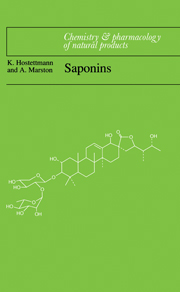Book contents
- Frontmatter
- Contents
- Glossary
- 1 Introduction
- 2 Occurrence and distribution
- 3 Analysis and isolation
- 4 Structure determination
- 5 Triterpene saponins – pharmacological and biological properties
- 6 Steroid saponins and steroid alkaloid saponins: pharmacological and biological properties
- 7 Commercially important preparations and products
- Appendices
- References
- Index of Latin names
- General index
5 - Triterpene saponins – pharmacological and biological properties
Published online by Cambridge University Press: 19 October 2009
- Frontmatter
- Contents
- Glossary
- 1 Introduction
- 2 Occurrence and distribution
- 3 Analysis and isolation
- 4 Structure determination
- 5 Triterpene saponins – pharmacological and biological properties
- 6 Steroid saponins and steroid alkaloid saponins: pharmacological and biological properties
- 7 Commercially important preparations and products
- Appendices
- References
- Index of Latin names
- General index
Summary
The widespread occurrence of saponins has meant that an awareness of these glycosidic plant constituents and their detergent and piscicidal properties has existed for centuries. Early investigations on their biological activities involved crude saponin mixtures but, with the introduction of sophisticated separation and structure elucidation techniques, the tendency is now to work with pure saponins or mixtures of pure saponins. Although certain properties of saponins are well defined, some effects are difficult to evaluate and, in other instances, responses are only manifested at high doses in experimental animals.
General properties of saponins
Generalizations about the solubilities of saponins are hazardous but many are soluble in water (particularly if the water contains small amounts of alkali) and alcohol; some are soluble in ether, chloroform, benzene, ethyl acetate or glacial acetic acid.
As already mentioned in Chapter 1, it is impossible to characterize saponins purely by their physical or biological properties. It is true that many share haemolytic, piscicidal, cholesterol complexation and foaming properties (Mcllroy, 1951) but the exceptions are too numerous for the use of these criteria in a global manner.
However, on the basis of historical considerations, the purely classical ‘general’ properties of saponins will be described. These rely mainly on their tensioactive nature. Of great importance is the interaction between saponins and cell membranes, with effects on the hydrophobic-lipophilic balance (HLB) and on membrane permeability. The precise nature of this phenomenon is unfortunately still unclear.
One of the most striking features of saponins is the enormous difference between mono- and bidesmosidic saponins, with bidesmosides either lacking or exhibiting an attenuation of the properties of the corresponding monodesmosides.
- Type
- Chapter
- Information
- Saponins , pp. 232 - 286Publisher: Cambridge University PressPrint publication year: 1995
- 7
- Cited by

